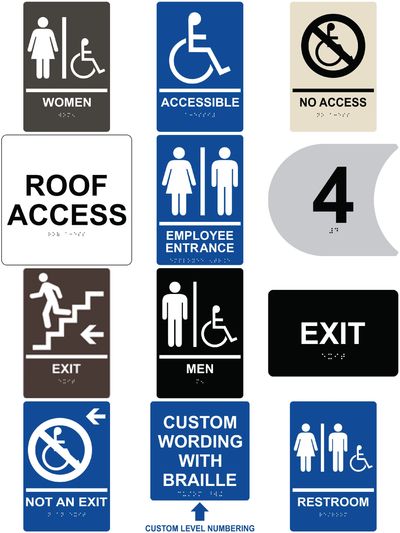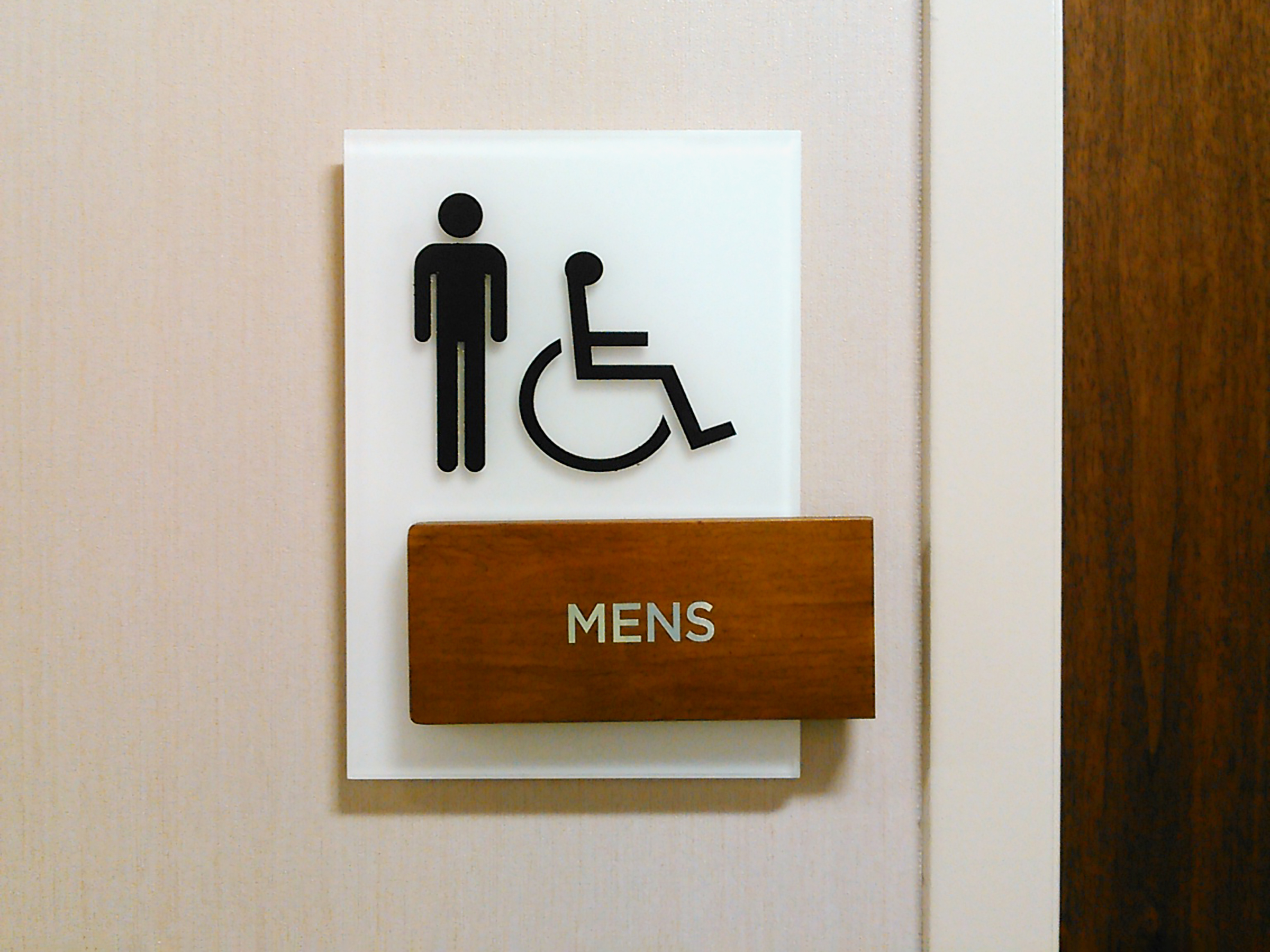ADA Signs: Making Sure Availability and Compliance in Public Spaces
ADA signs plays a crucial role in assuring access and compliance within public rooms, substantially adding to an inclusive atmosphere for individuals with impairments. By sticking to ADA requirements, signs not only assists in navigating but additionally highlights an organization's dedication to diversity and equal rights. As we check out the subtleties of ADA signage, from tactile functions to develop complexities, it's critical to consider just how these aspects coalesce to maintain the legal rights of all customers. What are the usual risks organizations encounter in keeping compliance, and how can future trends in signage continue to drive availability forward?
Importance of ADA Signs
In modern-day society, the relevance of ADA signs expands beyond plain compliance with legal mandates to symbolize a commitment to inclusivity and availability for all individuals. These signs are crucial in producing atmospheres where people with specials needs can browse public spaces with the very same convenience and self-reliance as those without handicaps. By providing standardized and clear information, ADA signs guarantees that everyone can access centers, solutions, and information without barriers.
The significance of ADA signage exists in its capacity to improve the high quality of life for individuals with specials needs by promoting equal access. It eliminates the challenges that could or else hinder their capacity to get involved totally in area life. Furthermore, these indications act as noticeable indications of an organization's dedication to variety and equality, showing more comprehensive social worths that champion the civil liberties and self-respect of all people.
In addition, ADA signs plays an important duty in public safety. By leading people to exits, bathrooms, and other important centers, it ensures that all people, despite physical capability, can evacuate securely during emergency situations. In summary, ADA signs is not just a regulative need yet an effective tool for fostering a inclusive and equitable society.
Trick Elements of Conformity

Positioning is vital; signs need to be mounted in locations that are reachable and conveniently noticeable. Typically, signage must be placed in between 48 and 60 inches from the ground to make certain access for both standing and wheelchair customers. Responsive elements, such as Braille, are crucial for individuals with aesthetic impairments, supplying essential information in a non-visual style.
High-contrast shades between the message and background are needed to enhance readability for individuals with low vision. The ADA mandates certain comparison ratios to guarantee clarity. Furthermore, personality dimension is an essential factor to consider, with minimal height needs dictated by the watching distance to make certain readability from different angles.
Design Considerations for Ease Of Access
Creating easily accessible signs requires a thorough approach to ensure it meets the demands of all customers, specifically those with handicaps. This involves considering various design components that boost readability and functionality. Secret aspects include the selection of font, shade comparison, and responsive attributes. Fonts need to be sans-serif, with easy and clear letterforms, to help with very easy analysis. The dimension of the text is equally important, with ADA guidelines suggesting a minimal height based on seeing distance to make sure readability.
Contrasting shades between text and history are necessary for presence, specifically for people with visual impairments. A high resource contrast proportion helps differentiate the message from its background, boosting readability under different lights conditions. Additionally, responsive aspects, such as Braille and increased personalities, are essential for people that are blind or have reduced vision. These elements must be located at a regular i thought about this height and setting to make sure simple accessibility and comprehension.
Additionally, the positioning of signage plays a significant duty in access. Indicators ought to be mounted in locations that are unhampered and easily obtainable. Making certain that signs is mounted at suitable heights and angles makes it possible for all individuals, consisting of those making use of wheelchairs, to interact with them efficiently.
Common Blunders to Avoid

Another widespread error is the inaccurate placement of signs. ADA guidelines define specific height and place needs to make certain that indications are quickly visible and reachable by all people, including those making use of mobility devices. Disregarding these guidelines not just hinders availability but additionally runs the risk of non-compliance with legal requirements.
Furthermore, inadequate contrast between message and background is a constant oversight. Ample comparison is vital for readability, especially for people with low vision. Designers in some cases choose shades that are visually enticing but lack the required comparison, making the text tough to determine.
Last but not least, some developers fall short to include responsive components, such as Braille, which are vital for people who are blind. Omitting these attributes not only leads to non-compliance with ADA laws however additionally restricts accessibility for a segment of the population that counts on responsive information.
Future Trends in Signage
Improvements in technology and enhancing recognition of inclusivity are shaping the future trends in signs layout. As culture becomes a lot more aware of varied demands, the combination of clever technologies right into signs is gaining grip. Digital signage, for circumstances, is progressing to consist of interactive functions and real-time updates, which can be vital in offering dynamic info in public areas. These indications usually integrate touch screens or gesture-based controls, making it possible for customers to browse content customized to their specific demands.
Another arising see this here fad is the use of augmented reality (AR) to enhance customer experience. AR-enabled signage can overlay digital information onto the physical environment, supplying visually impaired individuals with auditory or haptic comments. ADA Signs. This technology not just boosts accessibility but additionally develops an interesting experience for all customers
Sustainability is likewise a considerable element influencing signage trends. Green materials and energy-efficient lighting options are being prioritized to align with international ecological goals. Advancements in products science are leading to the development of even more long lasting and weather-resistant signs.
Verdict
ADA signs plays a crucial duty in guaranteeing ease of access and compliance within public rooms by including tactile components, high-contrast colors, and strategic positioning. The adherence to ADA criteria not only facilitates safe navigation for people with specials needs yet additionally symbolizes a company's dedication to diversity and inclusivity. By staying clear of usual errors and welcoming future patterns, public spaces can remain to advance these values, making certain that the rights and self-respect of all individuals are respected and promoted.
ADA signage plays a vital function in guaranteeing accessibility and compliance within public rooms, dramatically contributing to a comprehensive setting for individuals with specials needs. As we discover the subtleties of ADA signage, from tactile functions to develop intricacies, it's crucial to take into consideration exactly how these aspects integrate to promote the civil liberties of all users.In modern-day society, the value of ADA signage extends past plain conformity with lawful requireds to symbolize a commitment to inclusivity and availability for all people. By supplying standardized and clear information, ADA signage guarantees that everyone can access centers, solutions, and information without obstacles.
ADA signage plays a vital duty in guaranteeing availability and conformity within public areas by incorporating responsive components, high-contrast shades, and calculated positioning. (ADA Signs)